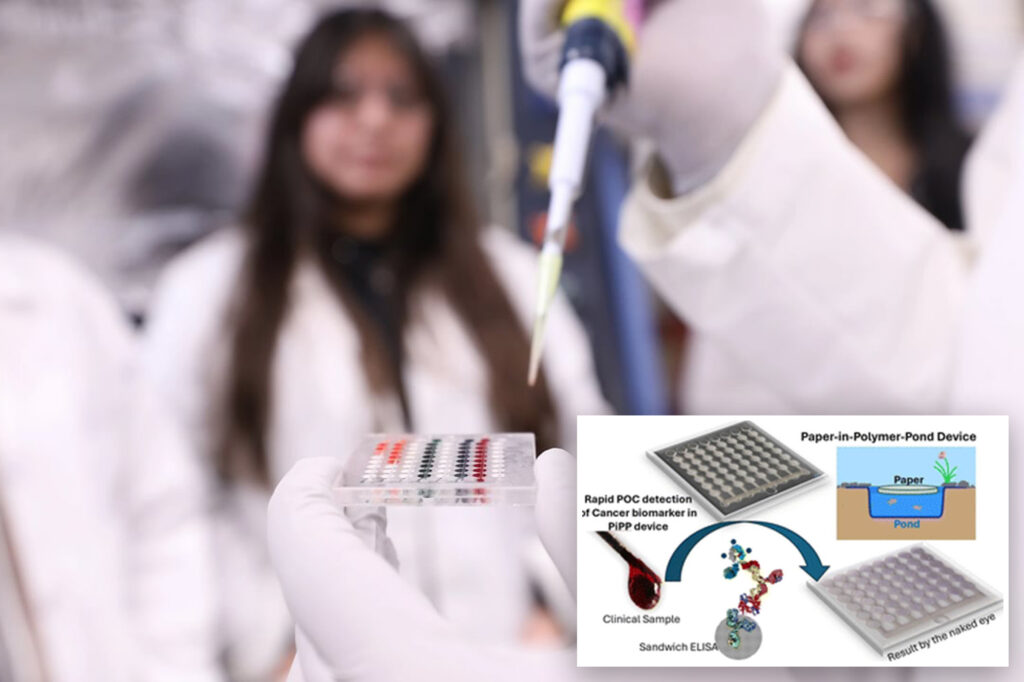🔴 Website 👉 https://u-s-news.com/
Telegram 👉 https://t.me/usnewscom_channel
A remarkable new device promises to make cancer detection cheaper, faster and more accessible than ever before.
As described in an upcoming issue of Lab on a Chip, researchers at the University of Texas at El Paso (UTEP) say they have developed a system that can detect cancer markers in the blood with greater responsiveness than current diagnostic methods.
Known as a paper-in-polymer-pond (PiPP) device, the new testing platform combines paper similar to the kind found in coffee filters with a plastic framework.
Using a drop of blood from a patient, the PiPP targets two cancer markers: carcinoembryonic antigen (CEA), which is linked to colorectal cancer, and prostate-specific antigen (PSA), which indicates prostate cancer.
CEA and PSA show up in the blood in the early stages of cancer, making them historically difficult to detect. However, the new device can catch these markers at low concentrations, making them roughly 10 times more sensitive than testing kits on the market.
“Our new biochip device is low-cost — just a few dollars — and sensitive, which will make accurate disease diagnosis accessible to anyone, whether rich or poor,” lead author XiuJun (James) Li, a UTEP professor of chemistry and biochemistry, said in a statement.
“It is portable, rapid, and eliminates the need for specialized instruments,” Li added.
This promising development comes on the heels of startling new research that suggests Gen X and millennial Americans are at higher risk of developing 17 cancers compared to older generations.
Colorectal cancer, which the PiPP device may be able to detect in its early stages, has been steadily increasing among adults under 50 since the ’90s. Young adults who develop colon cancer tend to be diagnosed at later stages of the devastating disease — and have more aggressive types of tumors, but the PiPP’s promise of earlier detection could equate to lifesaving intervention.
Prostate cancer is similarly fueling the current cancer epidemic, with 10% of new diagnoses in the US occurring in men under 55.
Deaths from prostate cancer are expected to jump 136% from 2022 to 2050 worldwide. As with all cancers, early detection is crucial — and the new PiPP device could prove to be a game changer.
And the device doesn’t just deliver early diagnoses but rapid-fire results. Compared to the 16 hours that traditional testing requires, PiPP delivers results in just one hour and those results can be read with a smartphone.
Researchers note that developing countries often lack access to cancer screening methods and resources like laboratory equipment and providers, a limitation that makes early detection difficult and mortality rates higher.
However, the PiPP device — which is affordable, reusable and user friendly — helps level the playing field for early diagnosis.
Robert Kirken, dean of the College of Science at UTEP, said that the innovation “significantly improves point-of-care diagnostics by reducing detection times and the need for costly instruments.”
“This makes it ideal for resource-limited settings, which will improve early diagnosis and lead to better cancer outcomes. I look forward to seeing what this innovation leads to,” he added.
While the potential is promising, it could be several years before the PiPP device is commercially available.
The prototype will be put to the test of efficacy and safety through clinical trials and will ultimately require approval from the US Food and Drug Administration before it is made available to health care providers.
